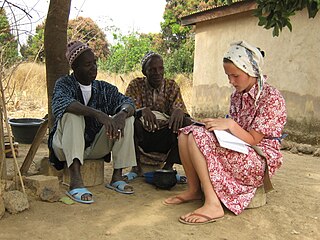
"Liberté" is the national anthem of Guinea. Adopted upon independence in 1958, it was arranged by Fodéba Keïta and is based on the melody of a Maninka praise song by Korofo Moussa for 19th-century Fouta Djallon king Alpha Yayo Diallo.

Ahmed Sékou Touré was a Guinean political leader and African statesman who became the first president of Guinea, serving from 1958 until his death in 1984. Touré was among the primary Guinean nationalists involved in gaining independence of the country from France. He would later die in the United States in 1984.

Guinea is a West African nation, composed of several ethnic groups. Among its most widely known musicians is Mory Kanté - 10 Cola Nuts saw major mainstream success in both Guinea and Mali while "Yeke Yeke", a single from Mory Kanté à Paris, was a European success in 1988.

Fouta Djallon is a highland region in the center of Guinea, roughly corresponding with Middle Guinea, in West Africa.

The Geba is a river of West Africa that rises in the northernmost area of Guinea in the Fouta Djallon highlands, passes through southern Senegal, and reaches the Atlantic Ocean in Guinea-Bissau. It is about 550 kilometres (340 mi) in total length.
Djibril Tamsir Niane was a Guinean historian, playwright, and short story writer.

Jean Suret-Canale was a French historian of Africa, Marxist theoretician, political activist, and World War II French Resistance fighter.
Ahmadou, was one of the last Almamis of the Fula Imamate of Futa Jallon, in the Futa Jallon region of today's Guinea.
Manjak people or the Manjaco are a West African ethnic group who primarily reside in Guinea-Bissau with smaller communities in The Gambia, and Senegal. The Manjaco constitute about 14% of the population of Guinea-Bissau. Within Guinea-Bissau, the people primarily live in the Bassarel and Babok areas in the northern coastal Cacheu Region.
Sirah Baldé de Labé (1929–2018) was a Guinean novelist and teacher.

Siradiou Diallo, a Fulani, was a Guinean journalist and politician of the opposition party Union for Progress and Renewal. He was a candidate during the 1993 Guinean presidential election where he received 11.86% of the vote. He also stood for presidency in the 1998 Guinean presidential election and the 2003 Guinean presidential election.

Nunez River or Rio Nuñez (Kakandé) is a river in Guinea with its source in the Futa Jallon highlands. It is also known as the Tinguilinta River, after a village along its upper course.

Jean-Baptiste Ernest Noirot was a French comic actor, photographer, explorer and colonial administrator in Senegal and French Guinea in West Africa. He became involved in scandal and was suspended in 1905 when two of his protégés were accused of extortion and other abuses of power, but later he was reinstated.

Jean-Marie Bayol was a French army doctor, colonial administrator and politician.

Aimé Olivier de Sanderval, comte de Sanderval, was a French adventurer, explorer of West Africa, entrepreneur and author.

Thierno Abdourahmane Bah was Guinean writer, poet, Muslim theologian and Fula political personality of Fouta Djallon. He is regarded as one of the most important representatives of Islamic science and Fula culture of Fouta Djallon.

Koumanthio Zeinab Diallo is a Guinean poet, novelist and playwright who writes in both French and Fulani.

Anna Fanny Marguerite Quinquaud (1890–1984) was a French explorer and award-winning sculptor. From 1925, she travelled to the French-speaking countries of East Africa where she created numerous sculptures and water colours inspired by her impressions of the local people. She exhibited them at the Galerie Charpentier and at the Paris Colonial Exposition in 1931. In 1932, she visited Ethiopia where she created a bust of Haile Selassie.

Alexandra Vydrina was a Russian linguist and researcher at the French National Centre for Scientific Research (Paris) specializing in research on African languages of Guinea.

The Boké Prefectural Museum is a regional museum located in Boké Prefecture, in the Boké Region of Guinea. Inaugurated in 1982, it is housed in a small fort constructed in 1878.

















